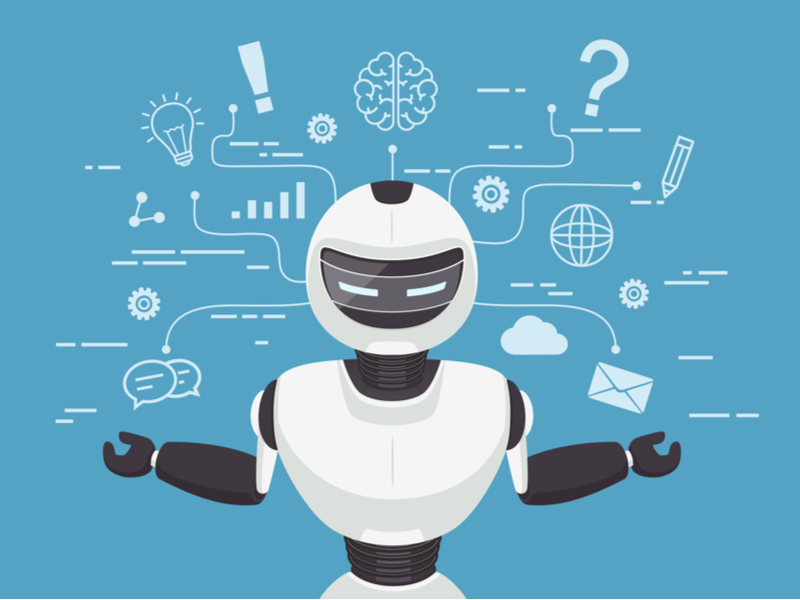6 stages AI Implementation into the company's processes
Automation of production or business processes of a company using artificial intelligence is rather a complex and time-consuming task. But if you go step-by-step and follow clear instructions, then the implementation of AI into your business will be successful and fast.
So how to start implementing AI into your company's business processes?
Final goal
As strange as it may sound, you need to start from the end - with the definition of the ultimate goal you want to achieve. This can be increasing sales or productivity, reducing costs and errors etc. It is important that the goal is measurable and achievable. For example, a 30% increase in revenue, a 25% decrease in equipment downtime, an 85% decrease in finished product rejects, and an increase in employee productivity by 50%.

In industrial and non-industrial enterprises AI implementation occurs in slightly different ways. In industrial organizations, processes associated with cognitive services are most often automated through smart video surveillance (including infrared cameras, thermal imagers, etc.), as well as optimizing equipment operating modes through predictive analytics. This allows you to reduce the percentage of rejects in finished products, increase safety and automate a number of processes.
In non-manufacturing industries, AI adoption most often starts with predictive analytics for sales or customer service. The benefits are most obvious and measurable here.
Data culture
Any process related to artificial intelligence requires a lot of data. Really large amounts of data. It's no secret that artificial intelligence appeared more than 50 years ago, and the mathematical basis of machine learning is more than 100 years old. However, it has become possible to use them effectively only now. The reason is largely due to the fact that over the past 10 years it has been possible to accumulate a sufficient array of data in the form of texts, photos, video images, records in CRM and ERP, indicators of telemetry sensors.
Collecting and storing data requires a certain way of working with data. At all stages of the business process, each employee must understand that all incoming and outgoing information is valuable for further analysis and forecasting. This is not obvious to many, so attention is required to instill in every employee the habit of collecting and storing data carefully.
Collection and preparation of data
Data collection may take some time. The word “big” in the term Big Data is not accidental. The data should be sufficient to reduce statistical errors, to train models, and form a control sample to determine the quality of the models.

Data science specialists will help develop a methodology for collecting and filtering data. They will then formulate the rules for their processing.
At the same stage, rules for processing incomplete data are formed (for example, some sensors did not work, some customer data is missing, etc.), additional features are formed that are important for the characteristics of the process.
As a rule, this stage is the longest, since the quality of the data is usually rather low, and
Developing models
When the preparatory work is completed, ensembles of models are built, which are trained on pre-collected data (usually 75-90% of the total sample), then the resulting models are tested on a control sample (the remaining 10-25%). Models that more accurately predict the results on the control sample are further improved by configuring the parameters of the model itself. Of course, this description is greatly simplified, in reality, the breakdown into test and training samples is mixed several times in order to improve the accuracy of the model and exclude random coincidence of the results.
Different models may be suitable for different tasks, an experienced specialist will select the right model faster, thereby saving time and resources. These will not necessarily be neural network models, which, although very powerful, are very resource-intensive, there are a large number of simpler and very effective methods that successfully solve the problems of classification, forecasting, clustering, etc.
Checking results and brain storms
When the models are built, the test data is predicted accurately, it is necessary to check the results against the new unknown for models data. This is not an easy task, since it is important to neutralize various cognitive biases caused by the very existence of a forecast.
People, as a rule, are not indifferent to the conclusions of AI and can both "adjust" real answers to the answers of AI, and vice versa, artificially underestimate the accuracy of predictions in order to leave processes as before.
In addition to the presence of the recommendations themselves from machine learning models, you can get an explanation why AI came to exactly such recommendations. That is, business analysts and technologists will receive information to better understand the processes, strengths and weaknesses of the product and correctly highlight the key points in the work.
Refinement of models
The information obtained as a result of checking on real actual data, even if it deviates from the forecast results, will help to refine the model. Most often, these results differ, since the current data differs from the archived data. In this case, the models are retrained so that they take into account the new data.
In addition, the refinement of the model must be carried out by the forces of business analysts, who can make artificial adjustments based on knowledge of technological and behavioral processes.
Further development
You can be sure that the process of implementing machine learning into your business will bring a number of indirect positive changes. You will see where the data was lost or distorted during the work. Careful attitude to the information of your employees will make them more responsible, analysts will receive a number of hypotheses to test. The management will be able to build interactive online BI dashboards based on the collected data and see the current state of the business.

However, even after achieving the initially set goals, the appetite will only grow stronger, the heads of departments will see how AI makes it faster and easier to achieve KPIs and reduces costs. This will be the beginning for further optimization of processes using machine learning, which will lead to more order in terms of working with data in the enterprise and ultimately have a synergistic effect across all departments.
New information entering the databases will strengthen models and improve forecasts.
By following these steps, the process of introducing AI solutions into your processes will be more predictable in terms of timing, results and cost. There will always be an opportunity to control the dynamics of work and make the necessary changes to the processes. In addition, the implementation process itself will allow you to significantly improve your business processes and increase productivity.
Our experts will help you analyze your processes and outline a roadmap on how to improve business efficiency using AI.


